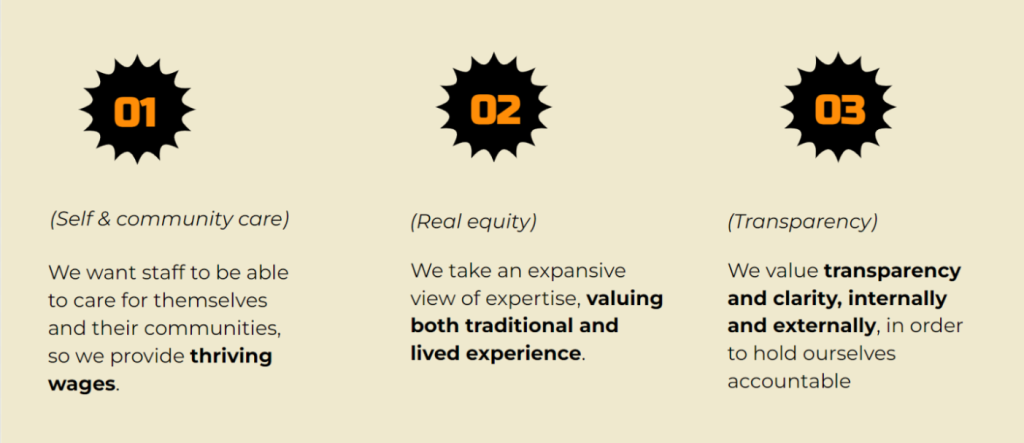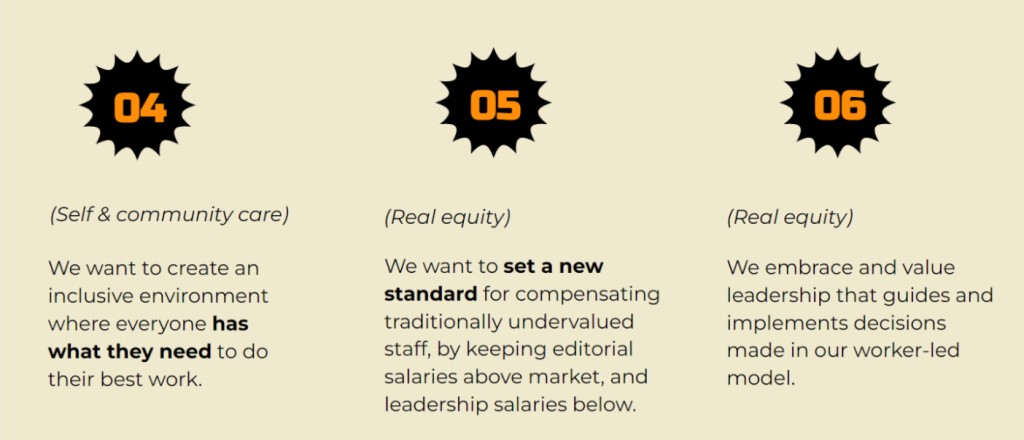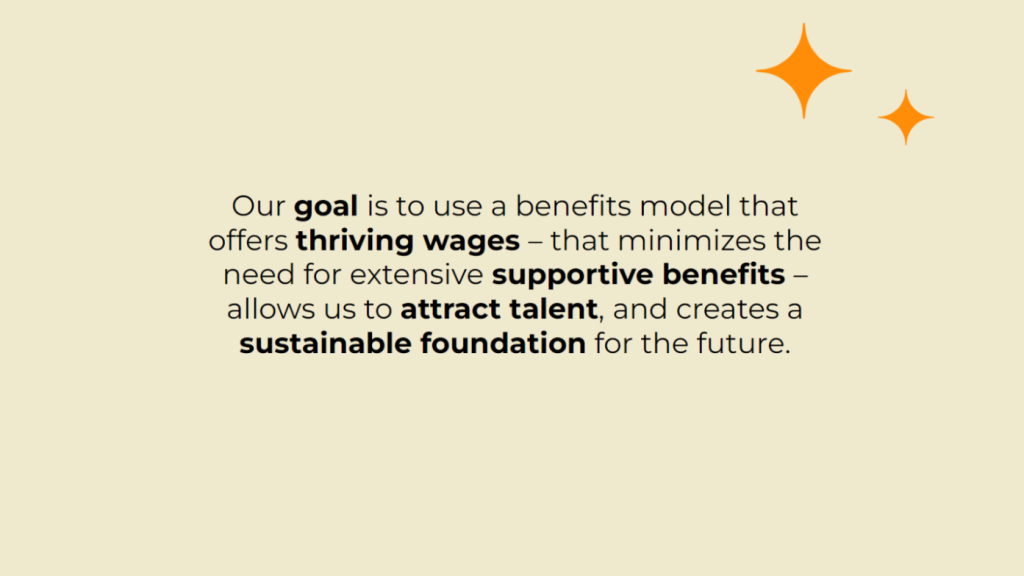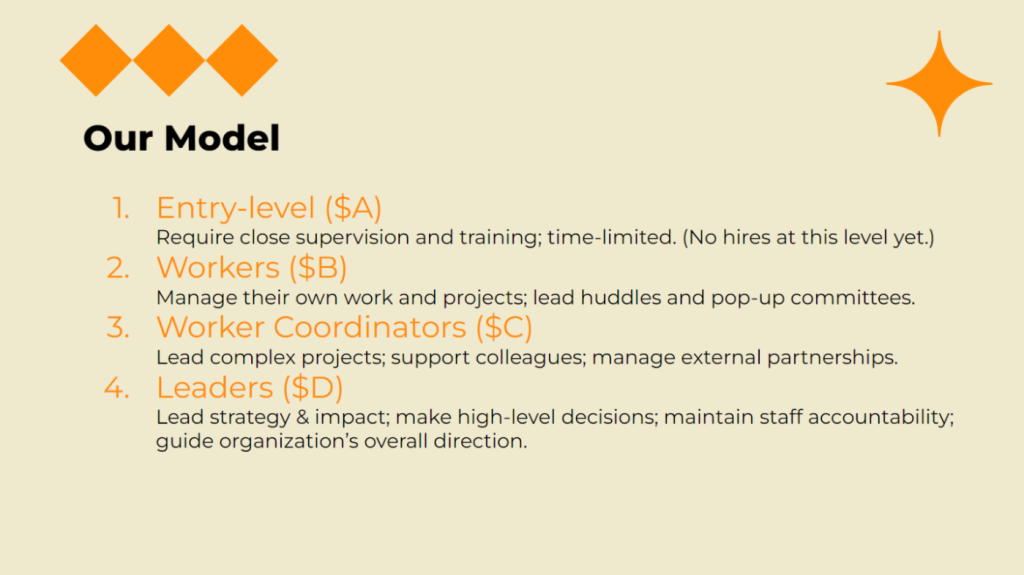
Photo: Alexander Grey | Unsplash
How we built equitable and thriving salaries
Figuring out a salary model is one of a newsroom start-up’s toughest challenges, but can also be one of its most rewarding
The views expressed in this column are those of the author and do not necessarily reflect the views of the Reynolds Journalism Institute or the University of Missouri.
In almost every newsroom, salaries are secretive, inequitable, and contentious. But it doesn’t have to be that way, particularly when you start a newsroom from scratch.
At The Appeal, we built a transparent and equitable compensation model that works for everyone.
We did this by looking at, and adapting, our values into a compensation philosophy, doing a LOT of research into different compensation models, and getting input from experts and our team.
In the end, we decided on a fully transparent, four-tier structure, with a flat ‘Thriving Wage’ on each tier. The Appeal offers a “thriving” rather than a “living” wage to allow for staff to live comfortably in almost all U.S. markets. It is our hope these wages allow staff to cover both needs and wants as well as contribute to paying off debt and adding to their savings.
Once again, we must thank the Sustainable Economies Law Center for their invaluable work on worker-self-directed nonprofits. While we went with a different compensation model, their thoughtful and input-driven approach shaped how we did this difficult work.
Here’s a step-by-step guide to building a different kind of compensation model:
1. Ask your team what they want
When it came time to figure out how to pay our team, we began with the most basic question: “What do you want our compensation structure to achieve and avoid?”
We had everyone write their answers straight onto stickies in a Google jamboard under two columns: Achieve and Avoid. We then asked clarifying questions and tried to get a sense of where there were throughlines of consensus without agreeing to anything.
Some of the common sentiments were that we wanted to achieve salaries that value staff (particularly after the financial sacrifices during our launch phase), pay transparency, caps on executive pay, and ways for staff to grow professionally and financially without managing people. Two key things we wanted to avoid was financially devaluing reporters and creating a system where the founding team earns more than future hires.
After this session, we spent time as a leadership team reviewing and discussing these answers, which helped us to build an internal gauge of what we felt would make our team feel valued.
2. Research different models
There are so many different ways you can organize structures and pay staff and an almost endless number of resources about the correct way to do it. We looked at more than two dozen models.
These may seem unusual approaches for a newsroom, but one consulting firm, Edgility, explained perfectly why this is so important if we want to build healthier newsrooms:
“The default approach to compensating talent isn’t equitable. So we can’t use the old rules and systems and expect different results. We [must] reimagine the process… to ensure decisions are grounded in your values.”
Here are some pay structures we evaluated:
| Compensation Models | Notes |
|---|---|
| Market rate | You can use this as a guide, and choose to offer X% of market rate salaries, but can maintain traditional inequities |
| Salary Ranges | A lot of work to execute for small teams |
| Seniority/ Experience | Can maintain traditional inequities |
| Local & National salaries | Works best for newsrooms with bureaus |
| Flat | Difficult to attract news leadership if without competitive salaries |
| Base pay + bonuses | Can lead to financial rather than mission-driven incentives |
| Base pay + responsibility | Pays differently based on the financial amount assigned to each level of responsibility, but likely requires professional advice to execute |
| Needs-based wage | Would involve making a lot of value-based determinations on what someone’s needs actually are. Plus, what happens if someone’s needs change, for better or worse? |
| Needs + wants wage | Similar to the above, it would put the organization in a position to determine individual wants and needs |
| Self-selected | Staff choose a salary from within a set range, but can perpetuate systemic inequities |
| Geo-neutral | Provide high enough wages that could support living in any market in the U.S., which means no adjustments if people move |
| Living Wage | Low and doesn’t account for people’s wants, savings, paying loans, etc. |
| Thriving Wage | Surpasses living wages and allows people to save, pay off loans, and enjoy life, but there’s no standard metric |
| Equity-based calculator | Would take into account cost of living, dependents, lived experience, etc, but we would have had to build this calculator |
To read more: We recommend resources from SELC, Edgility, Vega Mala Consulting, RoadMap Consulting, and CompassPoint.
Here are some organizational structures we evaluated:
| Compensation Models | Notes |
|---|---|
| Flat / Committees | Work is done in committees without a lot of hierarchy. |
| Career Paths | Allows people to increase in responsibility/seniority without taking on management roles. This was a lot of work to execute for a small team. |
| Job families | Groups staff based on different levels of responsibility |
3. Create a value-driven compensation philosophy
Setting up a compensation model is one of the biggest culture-defining decisions you make as a newsroom leader. For that reason, it’s important to look back at your organizational values.
Values can seem vague and unhelpful when setting up something as complex as compensation, so you’ll want to turn them into something more practical, like a compensation philosophy.
The Appeal’s core values when we began this process were transparency, real equity, self- and community care, transformational relationships, and feedback/growth.
The first three values seemed the most relevant to how people are compensated at work, so we focused on these. As leaders, we talked through and drafted how we wanted these three values to be represented in whichever model we chose.
This is what that looked like:


4. Think deeply about adjustments
Beginning
As thoughtful as many of these different compensation models are, many don’t address some of the concerns relevant to every newsroom, particularly new ones.
We looked at whether any one-time adjustments to basic pay structures might help address some of our biggest concerns around equity, including:
- Acknowledgment pay: One-time adjustment to help address historical inequities. To prevent a dynamic of requiring staff to self-select, this is offered to all staff who can then opt-out or choose to reduce the adjustment by 50%. (Learn more: SELC)
- Equitable merit: Are there certain lived experiences that you want to financially acknowledge through adjustments or signing bonuses? (Learn more: Harmonize)
- Founder bonus: A one-off payment can help acknowledge the financial sacrifices founding teams often experience in nonprofit news startups.
- Tax adjustment: Pays certain employees more to make up for differences in state and city taxes, but this is very difficult to manage.
Future
Even if you don’t know for certain how pay raises and promotions will work in the future, it’s a good idea to have a couple of ideas so staff know they won’t be stuck at this one salary indefinitely.
Here are a couple of options we looked at:
- Flat annual increase of X%
- Step increase of X% at certain years of employment
- Inflation increases
- Cost of living adjustment
- Flat + cost of living adjustment
- Cost of living adjustment + equitable merit raises
- Seniority based on time at the organization
- Individual performance
5. Create a shortlist
Doing all the research is one thing, putting it to use is another. As leaders, we had many, many conversations about what real equity looks like in practice. Should we pay more, or offer a hiring bonus, to people who have been impacted by the criminal legal system? What about people with high college debt? How do we account for the fact that staff will move between more and less expensive cities?
We went back to our Compensation Philosophy and, in line with this, began cutting the options down to models we felt like would support our team financially, value traditional and lived expertise, and promote equity. In the end, we had a couple of top contenders.
6. Get professional advice
Getting outside professional advice is critical. Not only to make sure your preferred options are legal, but because a good HR professional will help refine these options to be more in line with your company values and compensation philosophies.
7. Finalize your proposal
We decided to propose Thriving Wages as our compensation model. It felt equitable—empowering all people with enough funds to cover their needs and wants—while being relatively straightforward to implement.
Harmonize explains the benefits of this model well: “A living wage is an amount of money that enables a person to take care of the basic needs of themselves and their dependents. This means housing, food, health care, rest, and other essentials. A thriving wage is an amount of money that enables a person to feel a sense of security and abundance in the present, and build toward increasing security and abundance in the future. This means having access to goods, services, and experiences that provide enjoyment, personal growth, and healing…”
So then we had to figure out, what is a Thriving Wage?
To do this, we:
- Used the MIT Living Wage Calculator to determine the wage for 1 Adult + 1 Dependent in each of the areas we planned to have staff.
- Looked at media union contracts online to ensure our proposed numbers weren’t significantly below comparative roles.
- Researched past job descriptions with listed salaries for executive directors, editors in chief, editors, and reporters at other national, nonprofit newsrooms.
- Agreed that no one should earn less than what they did before our relaunch.
From there, we had a good idea of where we wanted our salaries to fall to be able to provide a Thriving Wage in most U.S. markets.
We also chose to include several adjustments:
- Salary cap, where the highest-paid employee can only earn 2.5X more than the lowest paid employee. The intended outcome is not to cap high-end salaries but to raise lower salaries when necessary.
- Cost of Living Adjustments are something we intend to bring in once financially able.
8. Lead a team discussion about Thriving Wages
As we’ve shared in detail by now, being a worker-led newsroom means our full team is responsible for big decisions like approving our compensation model. So, we held two working sessions to hash out details and get final approval.
Working session 1
The goal here was to get general consensus on our intention to use Thriving Wages. We also wanted to get feedback on the two structures and were torn between: Career Path vs Job Families.
- For a reporter, a career path could look like: Reporting Fellow → Reporter → Senior Reporter → Correspondent → Senior Correspondent.
- With job families, we would have associates + workers + coordinators + leaders, with internal progression involving more responsibility.
The feedback from our team was that Job Families seemed more straightforward for our small team.
Working session 2
A lot of work went into planning this session because we wanted to make sure we created a supportive, open environment for people to share their feedback on our final proposal. This is what the day looked like:
- Money talks: We spent the first hour or two just talking about all the things that can go wrong—and right—when it comes to money in the workplace. Getting people to share what they’re nervous about helps people feel heard. We asked our team to share examples of conversations that had gone bad, and well, in the past, talk about what myths we’re told about salaries, and share concerns about the conversations ahead.
- Here’s a Google Jamboard template to walk you through these conversations
- Set ground rules. When we were ready to move into the big conversations, we set ground rules about how everyone should communicate during this time.
- Proposed Thriving Wages. We presented what Thriving Wages with a Job Families structure could look like at The Appeal.

First, we explained a Compensation Goal that succinctly told the story of not just the model we were proposing, but what we were trying to achieve holistically:
Then we presented our final model:

Some of the critical elements of this model were:
- Every person on the same level earns the same amount
- We aimed to close the salary and power imbalance between traditionally well- and under-compensated newsroom employees while still providing competitive wages:
- We could equally value all that different people bring to The Appeal, recognize and compensate individuals who carry significant responsibilities
- Group discussions
Getting detailed feedback from everyone is very difficult, time consuming, and exhausting for all involved, so we broke up feedback into two parts.
First, we split staff into pairs and gave them a Google doc to share their thoughts in detail with one another. Here’s a Google Doc template to guide those conversations.
Then we brought everyone back together and had each pair answer these key questions about whether they supported the proposed salaries, whether these were thriving wages, etc. in a Google Jamboard. This time we asked for simple Yes/No answers, before opening up for a short conversation.
- Get final approval
Most nonprofit newsrooms require board members to be involved in determining compensation for your leadership team. So, we created a final proposal and got the okay from our board.
Because of all the work we put into getting our team’s input, factoring in their concerns, and keeping them informed throughout the process, the final step of getting their approval was the easiest part. We voted unanimously to adopt our compensation model.
A huge thank you to Alice Chin of Your Other Half and Michael Applegate of the Pacific Media Workers Guild who were invaluable thought partners as we evaluated many salary options early on.
Cite this article
Chan, Tara Francis and Greene, Molly (2024, July 22). How we built equitable and thriving salaries. Reynolds Journalism Institute. Retrieved from: https://rjionline.org/news/how-we-built-equitable-and-thriving-salaries/

